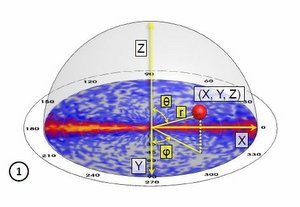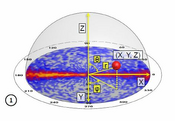Information
- Publication Type: Habilitation Thesis
- Workgroup(s)/Project(s):
- Date: July 2021
- First Supervisor: Eduard Gröller

- Date (Start): 1. January 2010
- Date (End): 16. July 2021
- Open Access: yes
Abstract
Visualization and analysis of primary and secondary X-ray computed tomography (XCT) data has become highly attractive for boosting research endeavors in the materials science domain. On the one hand, XCT allows to generate detailed and cumulative data of the specimens under investigation
in a non-destructive way. On the other hand, through the conception, the development, and the implementation of novel, tailored analysis and visualization techniques, in-depth investigations of complex material systems turned into reality, e.g., in the form of interactive visualization of
spatial and quantitative data, uncertainty quantification and visualization, comparative visualization, ensemble analysis and visualization, visual parameter space analysis, and many others.
Visual analysis of XCT data enables a detailed understanding of the internal structures and the characteristics of materials and thus facilitates studies on a multitude of phenomena, at multiple scales, in different dimensions, or even using different modalities. This was simply impossible
before. This habilitation thesis presents contributions to computer science in terms of novel methodsand techniques as well as respective algorithms and data structures, which are advancing visual analysis and visualization for enabling insights into XCT data on material systems. The introduced
methods and techniques focus on three distinct technical areas of visual analysis and visualization of XCT data. For each area, the problem statements, important research questions to be solved as well as the contributions of the habilitation candidate are discussed:
1. Interactive visualization of spatial and quantitative data: Visualization and analysis techniques are introduced in this thesis for exploring, encoding, connecting, abstracting
elaborating, reconfiguring, filtering, and finally selecting in "rich" XCT data. To reveal insights into complex objects, MObjects (i.e., mean objects) is discussed as a novel aggregation and exploration technique, which computes average volumetric representations from selections of individual objects of interest. To analyze various of these mean objects and to compare them with regards to their individual characteristics, visual analysis techniques as presented in FiberScout facilitate a detailed exploration of primary spatial data together with derived quantitative data (i.e., secondary data).
2. Visual parameter space analysis (vPSA): The contributions towards vPSA focus on concepts for exploring and analyzing the space of possible parameter combinations of algorithms, models, and data processing pipelines as well as their effects on the ensemble of results. The presented methods and techniques visually guide users in finding adequate
input parameter sets, leading to optimal output results. In particular, the vPSA of segmentation and reconstruction algorithms is investigated. Similarity Metrics are introduced for comparing features as well as their characteristics.
3. Comparative visualization and ensemble analysis: The comparison of larger sets of ensemble members as generated by vPSA is difficult, tedious, and error-prone, which is often
exacerbated by subtle differences in the individual members. Here, techniques are presented to study the differences between multiple results regarding their visual representation as well as their characteristics. Dynamic Volume Lines is a novel technique for the visual analysis and comparison of large sets of 3D volumes using linearization methods combined with interactive data exploration. This technique is accompanied by a comparative visualization in the spatial domain to establish a link between the abstracted data and real world representations.
Finally, in terms of visualization theory and modeling, this thesis abstracts the characteristics of visual parameter space analysis in a holistic conceptual framework. It also classifies and frames the novel area of visual computing in materials science, identifying research gaps within this
domain.
Additional Files and Images
Additional images and videos
Additional files
Weblinks
No further information available.
BibTeX
@habilthesis{Heinzl2021,
title = "Visualization and Analysis of X-ray Computed Tomography Data",
author = "Christoph Heinzl",
year = "2021",
abstract = "Visualization and analysis of primary and secondary X-ray
computed tomography (XCT) data has become highly attractive
for boosting research endeavors in the materials science
domain. On the one hand, XCT allows to generate detailed and
cumulative data of the specimens under investigation in a
non-destructive way. On the other hand, through the
conception, the development, and the implementation of
novel, tailored analysis and visualization techniques,
in-depth investigations of complex material systems turned
into reality, e.g., in the form of interactive visualization
of spatial and quantitative data, uncertainty quantification
and visualization, comparative visualization, ensemble
analysis and visualization, visual parameter space analysis,
and many others. Visual analysis of XCT data enables a
detailed understanding of the internal structures and the
characteristics of materials and thus facilitates studies on
a multitude of phenomena, at multiple scales, in different
dimensions, or even using different modalities. This was
simply impossible before. This habilitation thesis presents
contributions to computer science in terms of novel
methodsand techniques as well as respective algorithms and
data structures, which are advancing visual analysis and
visualization for enabling insights into XCT data on
material systems. The introduced methods and techniques
focus on three distinct technical areas of visual analysis
and visualization of XCT data. For each area, the problem
statements, important research questions to be solved as
well as the contributions of the habilitation candidate are
discussed: 1. Interactive visualization of spatial and
quantitative data: Visualization and analysis techniques are
introduced in this thesis for exploring, encoding,
connecting, abstracting elaborating, reconfiguring,
filtering, and finally selecting in "rich" XCT data. To
reveal insights into complex objects, MObjects (i.e., mean
objects) is discussed as a novel aggregation and exploration
technique, which computes average volumetric representations
from selections of individual objects of interest. To
analyze various of these mean objects and to compare them
with regards to their individual characteristics, visual
analysis techniques as presented in FiberScout facilitate a
detailed exploration of primary spatial data together with
derived quantitative data (i.e., secondary data). 2. Visual
parameter space analysis (vPSA): The contributions towards
vPSA focus on concepts for exploring and analyzing the space
of possible parameter combinations of algorithms, models,
and data processing pipelines as well as their effects on
the ensemble of results. The presented methods and
techniques visually guide users in finding adequate input
parameter sets, leading to optimal output results. In
particular, the vPSA of segmentation and reconstruction
algorithms is investigated. Similarity Metrics are
introduced for comparing features as well as their
characteristics. 3. Comparative visualization and ensemble
analysis: The comparison of larger sets of ensemble members
as generated by vPSA is difficult, tedious, and error-prone,
which is often exacerbated by subtle differences in the
individual members. Here, techniques are presented to study
the differences between multiple results regarding their
visual representation as well as their characteristics.
Dynamic Volume Lines is a novel technique for the visual
analysis and comparison of large sets of 3D volumes using
linearization methods combined with interactive data
exploration. This technique is accompanied by a comparative
visualization in the spatial domain to establish a link
between the abstracted data and real world representations.
Finally, in terms of visualization theory and modeling, this
thesis abstracts the characteristics of visual parameter
space analysis in a holistic conceptual framework. It also
classifies and frames the novel area of visual computing in
materials science, identifying research gaps within this
domain.",
month = jul,
URL = "https://www.cg.tuwien.ac.at/research/publications/2021/Heinzl2021/",
}


 HABILITATION THESIS
HABILITATION THESIS
